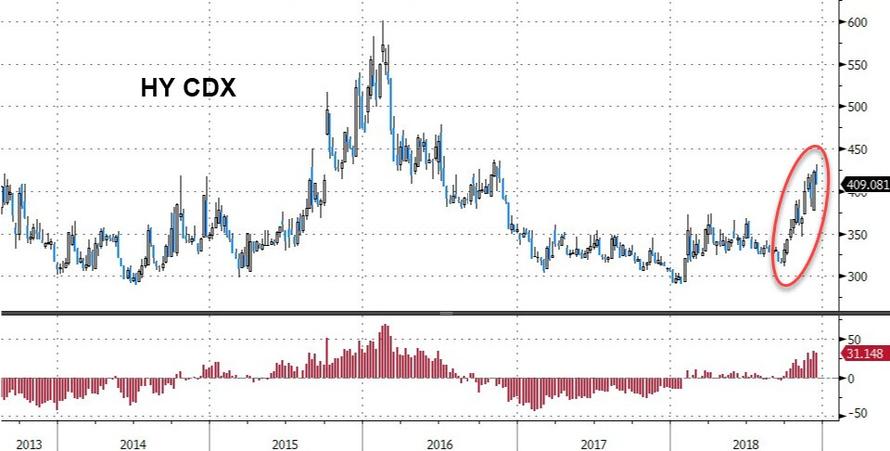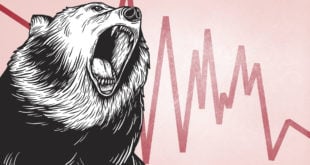I don’t want to pawn off the good work of Tyler as my own — so here’s the link to his story.
The importance of this narrative cannot be minimized. We have a situation that is very reminiscent of 2007 playing out now, with rates increasing into a slowing economy, wrought with dangerous amount of debt. Corporate America has $10 trillion in debt, most of it used for the purposes of buying back shares. By doing so, they leveraged into their business models. All is fine and good when earnings are bountiful — but what if those earnings became losses?
During the previous recessions, earnings for the S&P 500 fell by 65-75%.
Losses will be increased, much greater than 2008, and debt covenants shattered to pieces — write downs and bankruptcies will ensure — at a pace unseen before. This is the bearish narrative, woven with the cloth of burlap. You can never escape this fate, believe me.
Via ZH:
Prices for bonds rated CCC or lower (the weakest high yield credits) have dropped about 8.7% since the credit selloff started in early October, according to Bank of America Merrill Lynch Indexes. And as prices fall, yields on CCC-rated bonds have climbed to 11.5% – well above the current coupon around 8.1% (meaning dramatically higher refunding costs).
As about 34% of CCC-rated bonds come due in the next four years, up from 20% in 2010, according to Citigroup, Barrons notes that these companies will need to decide whether to pay down debt or refinance at higher rates. Either way, they will need to focus on cash.
All of which perhaps explains why, as The Wall Street Journal reports, bond investors scrambling to protect themselves from losses are increasingly using bets against the largest junk-bond ETFs.
The value of bearish bets on shares of the two largest junk-bond ETFs hit a record $10 billion in recent weeks, according to data from IHS Markit .
A record 59% of shares outstanding of the largest junk-bond ETF have been sold short, up from about 35% in September, according to data from S&P Global Market Intelligence.
WSJ reports that appetite to short the ETF, operated by iShares, has far exceeded the number of shares available to borrow; ETF brokers have created an estimated $2 billion new shares to meet the demand since the start of October, said IHS Markit analyst Samuel Pierson. Short sellers of stocks and bonds are constrained by the amount of securities they can borrow. But ETF brokers can create new shares specifically to lend them out, allowing for much larger bearish positions.
Additionally, negative bets (or hedges) on indexes of credit default swaps, or CDS, for junk bonds hit a four-year high in November, according to Citigroup .
“There’s been increased interest because people are concerned about the credit market as we get closer to the late stages of the credit cycle,” said Calvin Vinitwatanakhun, a Citigroup credit-derivatives analyst.
And, as we recently detailed, Morgan Stanley strategists now expect this bearish turn in credit to continue in 2019.
The tricky handoff from quantitative easing (QE) to quantitative tightening (QT) that is under way is central to the cracks that have appeared across risk markets and credit markets in particular. Global QE provided the necessary conditions for corporations to lever up, which is exactly how they responded.
Outstanding US corporate credit market debt has more than doubled from US$3.2 trillion in 2008 to well over US$7 trillion today, with the biggest chunk of it coming in the BBB portion of the credit curve, the lowest rung of investment grade ratings. High debt growth has translated to high leverage – BBBs with 31% of BBB debt leveraged at or above 4.0x.
Lower yields driven by QE had important consequences for investor behaviour as well. The search for yield became a driving force which led to substantial inflows into US credit, particularly overseas investors. Also thanks to the Fed emerging as a large non-price-sensitive, programmatic investor of agency mortgage-backed securities (MBS) as part of QE, fixed income investors became progressively underweight MBS and overweight corporate credit. As the cycle got extended, the net result of these flows into credit investments has seen the manifestation of late-cycle excesses in credit markets. High debt growth has led to high leverage and weak structural protections for credit investors.
With the transition into QT, these flows are reversing. We have a marked drop-off in 2018 of foreign investor flows into US credit investments.
The laymen can watch this unfold in HYG, JNK, and later on LQD.
If you enjoy the content at iBankCoin, please follow us on Twitter







All the moar reason Jerome will hike, so he can ease if necessary.
As I’ve been drumming for about a month, the poster child for corporate credit problems is GE.
If you want to know if a tech rally is real, look to AAPL (now under $170 again).
If you want to know if a credit rally is real, look to GE (now at even, having given up a 3.5% gain today).
If you want to hit the top of the kill box (whihc I will note has a sloped roof on the QQQs), those two stocks have to stop falling.
In 2008, GE made a 25-year low. It looks like it will surpass that this cycle.
This is a S&P **100** company we are talking about, but no problem, the economy and stock market will do fine, nothing to see here….
GE has fallen for a variety of reasons …but I believe they’re still numero uno in at least one area: superfund sites.
Last post for purely entertainment value or maybe just scary as hell).
– Thanks to Tesla, we now have robot cars that kill drivers and pedestrains by themselves
– The miltary has had automated killer robot guns for at least 10 years:
https://www.wired.com/2007/10/robot-cannon-ki/
– The robots have learned from the terrorists: a good way to kill a lot of people is to crash a jetliner, even when the autopilot is **not** engaged
https://gizmodo.com/after-lion-air-crash-boeing-reportedly-will-warn-that-1830273042
I don’t own a Roomba